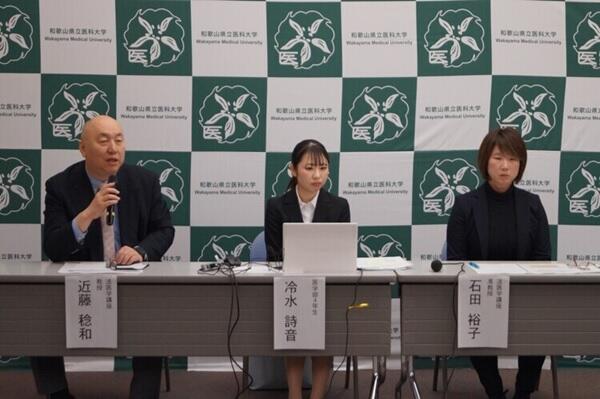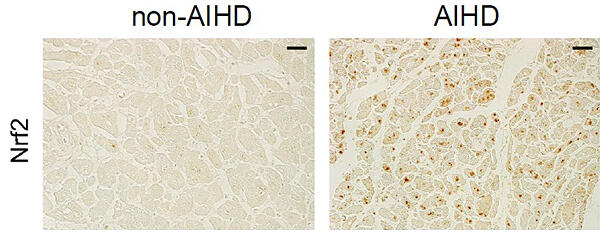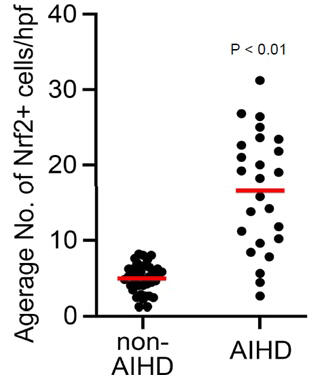On March 28, Professor Toshikazu Kondo, Associate Professor Yuko Ishida, and Graduate Student Shion Hiyamizu of the Department of Forensic Medicine at the School of Medicine at Wakayama Medical University, and their colleagues, announced that "Nrf2," a molecule that acts during cardiac ischemia, is useful for the forensic diagnosis of early-stage myocardial infarction. They observed that cardiac muscles were positive for this molecule in many cases in which myocardial infarction was considered to be the cause of death. Comparison with existing diagnostic indicators demonstrated its potential as a forensic diagnostic indicator. The results are expected to be useful for forensic diagnosis of myocardial infarction and were published in the international academic journal Scientific Reports.

Provided by Wakayama Medical University
Myocardial infarction occurs when a blood vessel supplying blood to the heart, such as the coronary artery, is so clogged that blood flow stops and the cardiomyocytes, which are responsible for heart movement, undergo necrosis. Moreover, acute myocardial infarction affects approximately 150,000 people annually and kills approximately 30% of them. Myocardial infarction is by far the most common cause of sudden death. However, myocardial infarction is difficult to detect after death, as heart examination methods such as electrocardiography, echocardiography, and cardiac catheterization cannot be used for diagnosis after cardiac function has ceased. The forensic diagnosis of myocardial infarction based on blood tests was also difficult because some components change after death.
Advanced-stage myocardial infarction can be detected by inspecting the tissue under a microscope for bleeding and cellular changes, but early-stage myocardial infarction is not associated with these and so is difficult to diagnose. Forensic medicine is the final form of medical care that protects human dignity through determination of the cause of death. In the case of sudden death, accurate forensic diagnosis is required to distinguish between death due to an accident or incident and death due to illness (e.g., myocardial infarction).
"Nrf2" is a molecule (enzyme) that acts during ischemia in cardiomyocytes. When oxygen is in short supply, various proteins are produced in cardiomyocytes, and Nrf2 plays a role in regulating the amount of protein production (transcription factor). It is present in the body from the beginning and is found at an elevated level in early-stage myocardial infarction. Therefore, the human forensic autopsy cases were divided into the myocardial infarction group (25 cases) and non-myocardial infarction group including other causes of death (39 cases), and the researchers examined whether Nrf2 expression differed between these two groups. As a result, expression was detected in the nucleus of cardiomyocytes in the myocardial infarction group. Moreover, a significant difference in the number of Nrf2-positive cells was observed between the myocardial infarction group and the control group.

Provided by Wakayama Medical University
Compared to previously used indicators of myocardial infarction (FN and C5b-9), the absolute evaluation was higher, indicating that Nrf2 expression is useful for forensic diagnosis of early-stage myocardial infarction. Combined with existing diagnostic methods, the new indicator can be used for more accurate postmortem diagnosis of early-stage myocardial infarction.

Provided by Wakayama Medical University
At the press conference, Hiyamizu revealed the difficulties she had in chemically staining intranuclear Nrf2. Kondo also commented, "This work finally succeeded because during this process of trial and error, which lasted for several years, Ms. Hiyamizu found time in her busy schedule of classes and practical training to look through a microscope late into the night."
Journal Information
Publication: Scientific Reports
Title: Forensic significance of intracardiac expressions of Nrf2 in acute myocardial ischemia
DOI: 10.1038/s41598-024-54530-x
This article has been translated by JST with permission from The Science News Ltd. (https://sci-news.co.jp/). Unauthorized reproduction of the article and photographs is prohibited.




